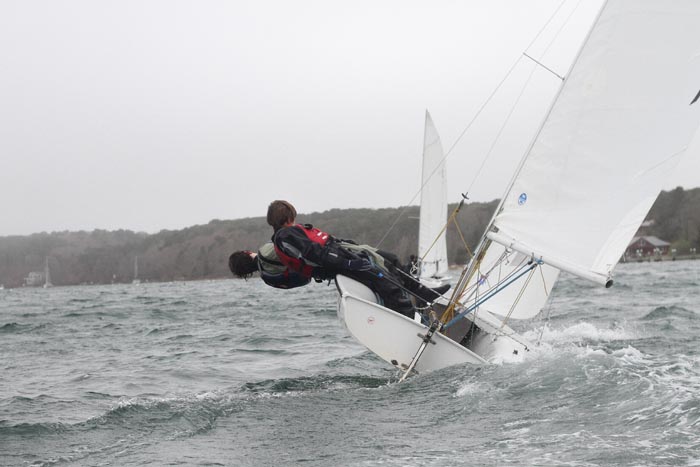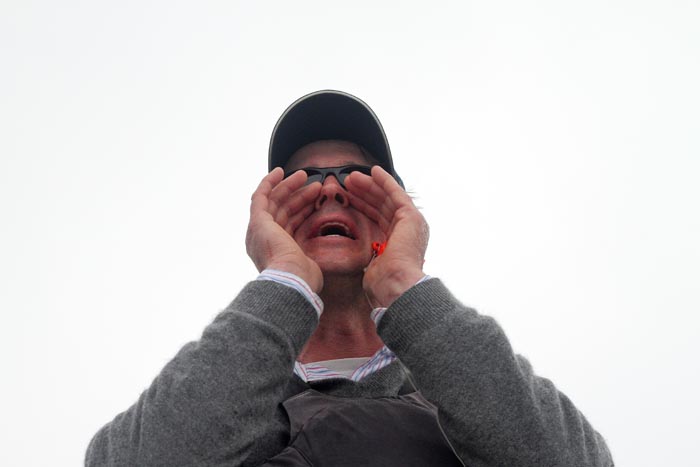Unlike other spring sports at Martha’s Vineyard Regional High School, sailing can’t move indoors in inclement weather.
The team is on the water most afternoons, after catching the bus from school to Sailing Camp Park (parent organization Sail MV provides the facilities and equipment for the team). When it rains, they rig up the boats. When there’s no wind, they go out and practice nonetheless. And if there’s a late-season snow shower, well, the team’s still on the water. About the only thing that can keep them inside is lightning.
Not that anybody seems to mind, because regardless of the conditions around them the sailors get to be on the water.
Being able to go out on the water and sail every day is the best part of being on the team, said senior captain Ben Nivala in an interview with the Gazette. Ben joined just last year, but, like many of his teammates, has been sailing for much longer (eight years, in his case).
Sailing as a varsity sport is a different breed from sailing as a recreational pursuit, however, and team racing — the Vineyarders’ typical competition format — is an entirely different species. Three boats per team, each manned by a skipper-crew duo, race a predetermined course, which typically follows a “digital N” path (so named because it resembles a dot-matrix form of the letter). The up-and-down paths ensures that the boats can’t get away with just sailing; they must tack, and tack often. The aim is not for an individual boat to win, but, as the name implies, to sail so that the team as a whole outpaces its opponents — a cross-country meet if the meet took place on the water.
And that element adds an extra level of strategizing, maneuvering and out-maneuvering to the sport.
“Team racing’s a lot like chess,” offered sophomore skipper James Ulyatt.
“It’s aggressive, it’s fast,” said head coach Andrew Burr, now in his sixth year with the team. Mr. Burr is assisted this year by Tristan Lodge, a former team member. Mr. Lodge primarily works with the eighth graders, who practice with the team; the eighth graders are part of the Sail MV program, not the varsity program. But having two coaches on the water is invaluable, particularly early in the season when the learning — and relearning, for those who’ve never team raced — curve is so steep.
“It’s tough in the beginning of the season when you’ve got a very large disparity between the top and the bottom,” said Mr. Burr. “I think we were very fortunate this season in that we were able to get some of those new kids up to speed very quickly.”
Getting up to speed means not only mastering the controls of a boat but also mastering a level of autonomy not present in most sports. During regattas, a coach can communicate with his team only until two minutes before the start of a race. Once the warning whistle blows, there can be no encouragement from the sidelines, no visit to the mound.
“It’s all up to us to make the plays,” said Ben. As skippers, Ben, James, and junior Jesse Thomas are responsible for steering the boat and making the major tactical decisions.
The crew members — typically senior Cole Bilodeau, sophomore Katie Johnson, sophomore Tyler Shapiro and junior Jake Sudarsky — have the somewhat daunting task of being on the same brainwave as the skipper throughout the race and adjusting the boat accordingly (as well as making sure the boat doesn’t crash into anything).
“When you watch the best double-handled sailors in the world, there’s not really a lot of dialogue,” said Mr. Burr. “You don’t necessarily have to talk all the time, and that’s not a bad thing.”
Indeed, Lagoon Pond was relatively quiet last Saturday, despite the competition happening at its center. The team was racing against Harwich, one of the 12 schools in the Cape and Islands League that includes the Vineyard. Cape and Islands is itself a division of New England Schools Sailing Association, part of the Inter-Scholastic Sailing Association.
“This is a nice place to sail because it’s protected and you don’t get a huge amount of wave action,” said Mr. Burr, adding that Falmouth’s team used to have to sail on Vineyard Sound, where they often dealt with four-foot chop during early spring practices.
“[Lagoon Pond] tends to be a bit more shifty,” he continued. “In team racing you want a little bit of shifty conditions, or it’d be boring.”
The coaches moved the race course several times during the afternoon to account for the changing wind direction.
The Vineyarders and Harwich raced a best-of-five series, with each race taking 10 to 15 minutes. Harwich outsailed the Vineyard in the first, but the team began to regroup in the second race, with boat 1 (Jesse Thomas and Jake Sudarsky) neatly cutting off a Harwich boat at the very end to take a third place spot. After four races, the series was tied.
“You have to be decisive,” said Jesse, who continued to spend most of the races maneuvering himself and Jake into the paths of Harwich boats, freeing up the course for his teammates.
To win as a team — and the Vineyarders do, by taking the fifth and final race of the day — it helps to be invested in your fellow sailors.
“The last couple years, the team hascome together as a group,” said Mr. Burr. “They’re good friends, they get along well.”
“Our team is really close,” affirmed Ben, before telling of an off-the-water group outing to see Thor the night before the Harwich regatta. The Vineyarders spend more time together than many other teams — nearly all the sailors also participate in the fall program (considered a club sport, as regulations prevent any sport from having two varsity seasons) and sail throughout the summer.
But the team racing season retains a position of honor.
“Team racing — not everybody can do that,” said Ben.








Comments
Comment policy »